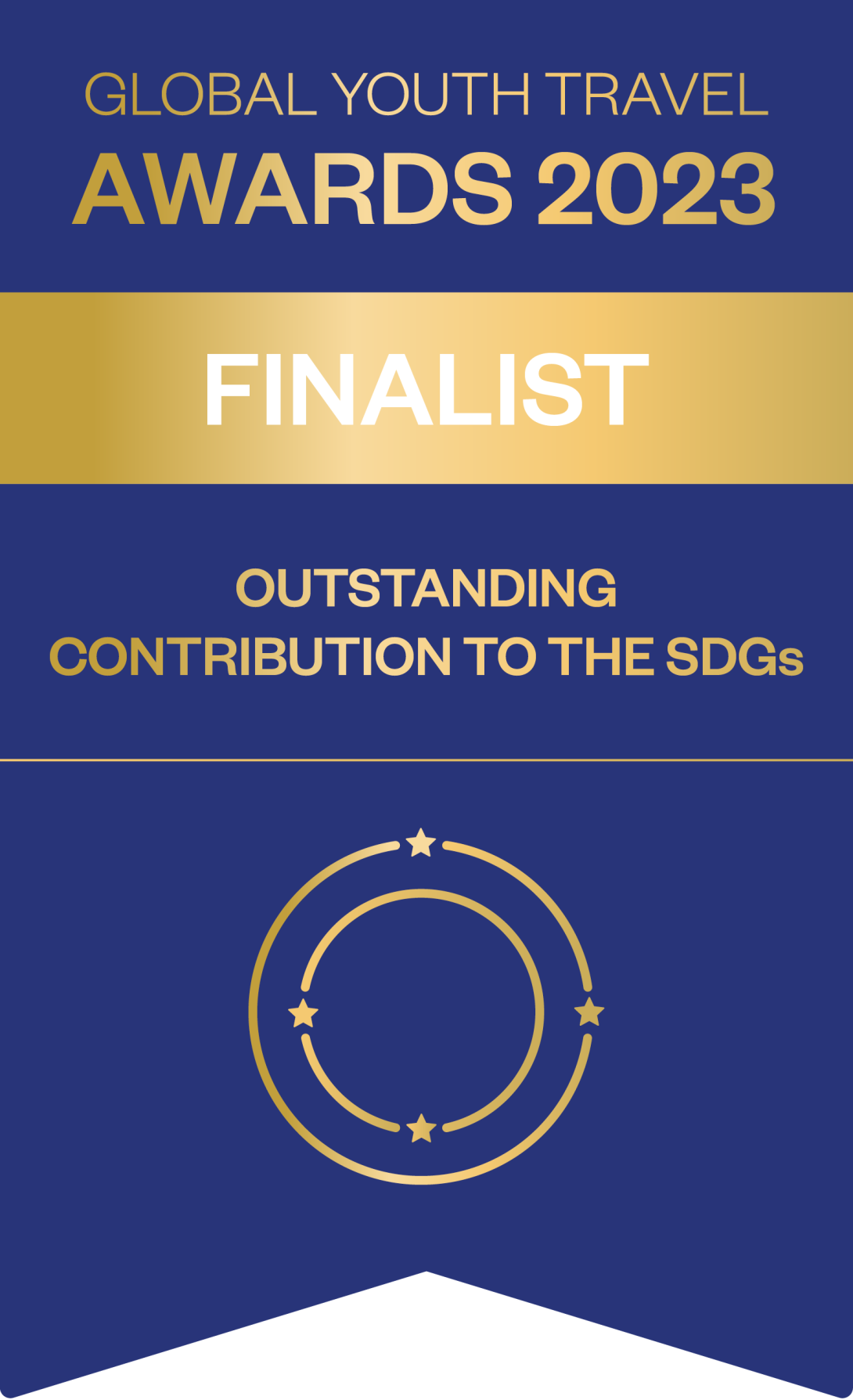In 2021, we became a founding member of the Glasgow Declaration on Climate Action in Tourism, and a signatory of Tourism Declares a Climate Emergency.
Tourism Declares is a global community of travel organizations committed to working together to create a better future for global tourism.
At Projects Abroad, we strive for high-impact Projects and low-impact travel. We believe that sustainable travel is essential for the future of our planet.
That’s why we’ve developed this Climate Action Plan, to explain how we’re trying to take action against our own footprint.
Our Climate Action Plan has three elements: measure, reduce, and mitigate.
1) How We Measure Our Carbon Emissions
We asked an independent consultancy firm, CLevel, to help us measure our emissions and produce a framework for ongoing emissions. They use the latest DEFRA carbon conversion factors to calculate our carbon footprint.
They calculated our business carbon emissions based on office electricity consumption, home working, and commuting, plus staff travel and accommodation to/from and within our destinations.
They also calculated our participants' carbon emissions based on food, accommodation, and transport within a destination. This includes an addition for the relatively higher consumption of participants as visitors vs. if they lived in that location full time.
Our calculations
Our average carbon footprint is 0.25 tonnes CO2e per participant in 2024. See Participants’ Carbon Emissions below to understand how we calculated this.
To give you an idea of what this means, one person driving a medium family petrol car (1.4L - 2.0L) for 1,500 km would emit about 250 kg of CO2e. This is about ten round-trip flights between Brighton and London or five round-trip flights between New York City and Philadelphia.
Business Carbon Emissions 2024
- Energy - electricity: 15.3 tonnes CO2e
- Commuting + working from home: 20.56 tonnes CO2e
- Staff travel: 90.41 tonnes CO2e
- Staff accommodation: 9.74 tonnes CO2e
Total for business: 197.12 tonnes CO2e
Participants' Carbon Emissions 2024
To arrive at a figure for carbon emissions per participant, we took the following total and divided it by the total number of participants in the same period.
- Accommodation: 153.7 tonnes CO2e
- Food: 367.75 tonnes CO2e
- Airport transfers: 6.21 tonnes CO2e
- Transport to/from placements: 18.59 tonnes CO2e
Subtotal: 565.25 tonnes CO2e
- +20%: 113.05 tonnes CO2e
Total for participants: 678.3 tonnes CO2e
We add 20% to the calculated travel carbon footprint of all our participants to account for the fact that they are likely to purchase more goods and services during their trip than people who live locally e.g. gifts, souvenirs, toiletries, and more.
Total for Business + Participants: 814.01 tonnes CO2e
To ensure prudence, we incorporate a 10% contingency to accommodate any unforeseen variations.
+10% = 895.41 tonnes total CO2e emissions.
We are confident that we have designed a solid framework for 2024. We are excited to develop this model and include any new methods as the data becomes available.
Keep reading for more details on each area listed above.
Office energy consumption
Our offices produced a total of 7.91 CO2e tonnes of emissions. We included an estimate for all home working. When combined, the total emissions are 13.91 CO2e.
Airport transfers and transport to/from placements
We recorded the average distance (km) between arrival airports and accommodation traveling in a private vehicle. We then multiplied the total kilometers traveled by the number of airport pickups and drop-offs.
For participants commuting between their placements and accommodation, we calculated the average distance between both based on the mode of transport (such as bus, taxi, boat, etc.).
We used local data when available – for instance, tuk tuks emit 2 kg CO2e per km – but when data was not available, such as matatu (Kenyan minibus), we used public bus figures instead.
We always choose representative alternatives with an anticipated higher emission total so as not to underestimate emissions.
Food
To work out the total number of eating days, we calculated the total number of working days of our participants and staff for the reporting period.
The total eating days for each diet were multiplied by:
- 5.63 kgCO2e/day for meat eaters
- 3.81 kgCO2e/day for vegetarians
- 2.89 kgCO2e/day for vegans
This is based on a 2014 study, ‘Dietary greenhouse gas emissions of meat-eaters, fish-eaters, vegetarians and vegans in the UK.’
There isn’t reliable data in many of our countries on food emissions, so we chose UK emissions as they will be higher than our destinations.
Accommodation
We have four categories of accommodations where our volunteers and interns stay:
- Host families
- Hotel
- Guest houses
- Camping/solar-powered eco-lodge.
CLevel calculated the number of total nights per category and multiplied it by the factors for each country.
We used the UK Government factors for hotel rooms/night for various countries as a source.
If the data wasn’t available, we chose to use the available factors from the closest representative country.
Staff and Volunteer Flights
As we have no influence over participant flights, we do not include their flights in our calculations. However, we created a Flight Carbon Calculator to make it easy for our staff and participants to calculate and offset their flight carbon emissions.
2) How We Reduce Our Carbon Emissions
We’re acutely aware that the best method of cutting carbon emissions is not to make them in the first place. This is our priority, and we constantly review project designs to reduce emissions.
In 2024, we achieved a 9% reduction in emissions vs. 2023, mainly due to moving meetings online and reducing the need for travel.
What we’re currently doing:
- Adapting all Projects to reduce carbon emissions as much as possible. This includes replacing internal flights with trains and other public transport, sourcing food locally, and arranging carpool options for independent weekend activities.
- Running awareness campaigns on our Conservation Projects to encourage the public and our participants to make climate-conscious choices.
- Creating organic vegetable gardens in schools that reuse recycled plastic bottles
- Running initiatives dedicated to plastic clean-ups on our Marine Conservation Projects.
- Encouraging our volunteers and interns to choose direct flights without layovers and consider compensating for the emissions from their flights by supporting reforestation efforts.
In the coming years, we aim to do the following:
- Eliminate the use of single-use plastics across our trips (plastic contains lots of ‘embodied carbon’) and replace them with reusable materials.
- Weigh and recycle all office waste, such as old tech equipment, food waste, and furniture.
- Go paperless.
- Find more accommodations where our volunteers and interns can walk or cycle to work.
- Encourage everyone to use public transport where possible.
3) How We Mitigate Our Carbon Emissions
We're committed to balancing our carbon emissions and investing in reforestation practices that extend well beyond carbon neutrality.
Here's how it works:
- Contingency: We calculate our emissions (100%) and then add a 10% buffer to our calculation to account for any unexpected variations.
- Offsetting: Through our partnership with Ecologi, we offset all of the CO2e we produce.
-
As per our calculations above, in 2024 we produced 814.01 CO2e tonnes of emissions that we need to balance. When we add 10%, this means we have offset 895.41 CO2e tonnes.
-
By doing this, we are contributing to the expansion of protected areas, supporting sustainable livelihoods, restoring degraded landscapes, and promoting carbon avoidance.
-
- Tree Planting Initiative: But we don't stop at offsetting – we're dedicated to capturing more emissions than we generate. For every participant in our programs, we plant a tree through Ecologi or our own long-standing carbon management program.
Starting in 2014, we have planted over 237,500 trees, including 184,500 mangroves. Mangroves play a crucial role in the fight against climate change, being up to four times more efficient at storing carbon dioxide than other forests.
Notably, our efforts in Fiji alone have seen volunteers plant over 15 acres of mangroves since the project's inception in 2014 and are recognized by the United Nations Development Programme.
This approach ensures that we not only offset our emissions but actively contribute to environmental restoration and sustainability, making a lasting impact on the fight against climate change.
Future Planning: Our Ongoing Commitment
While we strive for perfection, we recognize that we're not there yet. However, we're fully committed to transparently sharing our progress and findings as we work towards making travel a part of the solution, not a part of the problem. Our dedication is not only to our participants and staff but also to our partner communities, who are most vulnerable to the impacts of the Climate Crisis.
Our primary objective is to minimize emissions from our operations even further because we understand that the best way to address climate change is not emitting in the first place. This means implementing an annual review of our logistics to identify and implement efficiencies. We will continue to update our communications to keep you informed about our progress.
Join Us in Making a Difference
If you have any suggestions or insights that can help us improve, please don't hesitate to email us at support@projects-abroad.org. We value your input and appreciate your engagement in our mission.
Alternatively, you can join one of our projects and become part of the solution yourself. Together, we can make a real and lasting difference for our planet.
Join a Conservation Program
1-3 of 23 Projects

Giant Tortoise & Sea Lion Conservation in the Galapagos Islands
See this project- Price: $2,610 USD for 1 week
- Extra Weeks: $450 USD
- Start Date: Anytime
- Minimum Duration: 1 week
- Ages: 16 or over

Gap Project: Peru & Galapagos Islands
See this project- Price: $7,955 USD for 8 weeks
- Extra Weeks: $300 USD
- Start Date: Throughout the year
- Minimum Duration: 8 weeks
- Ages: 17-24

Rhino Conservation in Nepal
See this project- Price: $3,200 USD for 2 weeks
- Extra Weeks: $470 USD
- Start Date: Anytime
- Minimum Duration: 2 weeks
- Ages: 16 or over
Want to get involved?
Contact us now
or
Request Infoto start planning your project
Next Steps
Our accreditations


















